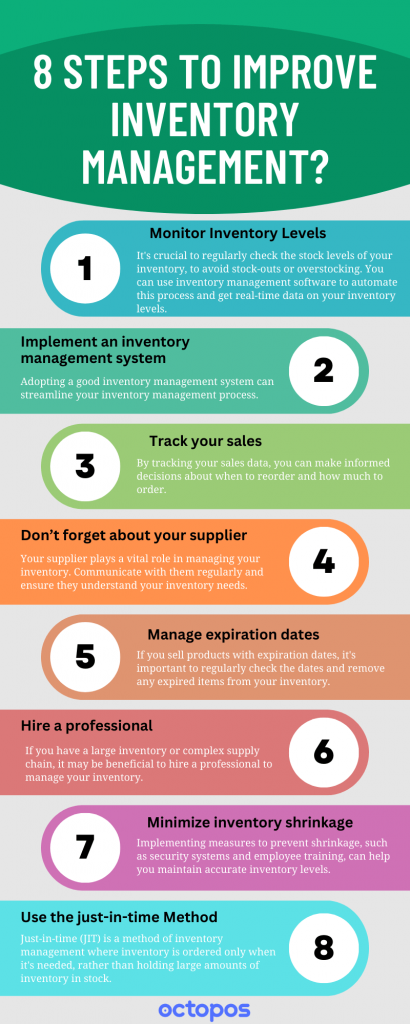When it comes to running a successful business, inventory management is essential. It’s important to make sure you have enough of the right products in stock, but not too much that it ties up capital or takes up valuable storage space.
Having a well-managed inventory will only lead to positive outcomes, such as reducing costs and increasing customer satisfaction. Every time the wrong item is sent out or something isn’t in stock, it can result in a customer being unhappy and potentially not returning.
So it’s better to be proactive and get your inventory management right. In this article, we’ll look at everything you need to know to improve your inventory management.
Table Of Content
What is Inventory Management?
Steps of Inventory Management
What is The First Step of Inventory Management?
Why is Inventory Management Important?
How to improve inventory management?
What is Inventory Management?
Before we jump into the ways to improve your inventory management, let’s first define what it is.
Inventory management is the process of tracking and controlling stock levels within a warehouse or storeroom. This includes monitoring the movement of goods in and out of the storage space, managing any associated costs, and ensuring that customer orders are fulfilled on time.
The purpose of inventory management is to reduce costs and ensure that products are always available when customers decide to make a purchase. It’s the process of ordering, storing, using, and selling items in a way that minimizes cost and maximizes productivity.
It also involves tracking inventory levels and knowing when it’s time to order more items to meet customer demands.
Inventory management is important for any business, regardless of size. For example, grocery stores must learn how to manage their inventory to have the right items available at all times.
Likewise, a manufacturing facility must accurately track inventory levels to ensure that it can fulfill customer orders on time.
In short, inventory management helps businesses stay profitable by ensuring that the correct amount of goods is available to meet customer demands and minimize costs associated with overstocking or understocking.
Without proper inventory management, businesses will struggle to remain efficiently stocked with the right products while keeping costs low.

Steps of Inventory Management
Inventory management includes several steps:
1. Purchasing the inventory
So the first step in the inventory management process is purchasing the items you need.
This includes researching suppliers, comparing prices, and selecting the right products to meet customer demand. It’s important to purchase your inventory from reliable sources that can provide quality goods at a fair price.
2. Tracking inventory movement
Once you have the items in stock, it’s essential to track any movement of the inventory. This includes monitoring incoming shipments and tracking any items that are sent out.
Tracking inventory movement helps you identify problems quickly so that they can be addressed before they become major issues. It also helps to ensure that your business always has the right items available to meet customer demand.
3. Reordering stock
Once your inventory levels begin to dip, it’s time to reorder more goods. This involves placing an order with a supplier and ensuring that the items arrive on time to keep up with customer demand.
This also means that you’ll need to be aware of lead times when ordering items. Lead time is the amount of time it takes for your order to arrive after you place it with a supplier.
4. Storing and sorting the items
Once your items arrive, it’s important to store them in a way that makes them easy to access when they are needed. This could involve sorting items into categories or bins and labeling each item clearly.
This also involves having the right storage space to ensure that items are accessible, secure, and well-maintained. Without proper storage, items can become damaged or lost and custom orders may not be fulfilled on time.
5. Placing customer orders
When a customer places an order, it’s important to find the item quickly and accurately. This requires having good tracking systems in place and knowing where items are stored.
It also involves having well-trained staff who know how to locate items quickly and efficiently. Having the right tools can help make this process much smoother.
You have to be very careful when placing customer orders since mistakes can lead to lost sales and unhappy customers, which is the last thing any business wants.
6. Monitoring the inventory levels
The next step in inventory management is to regularly monitor the inventory levels. This helps ensure that you always have enough items on hand to meet customer demand and stay profitable.
It also allows you to identify problems quickly and address them before they become larger issues. Monitoring inventory can also help you spot trends in demand so that you can adjust your ordering accordingly.
You can use a POS system, inventory software, or even a spreadsheet to keep track of your inventory levels.
7. Analyzing and adjusting
The final step in inventory management is to analyze the data and adjust your systems as needed. This could include identifying areas of improvement, reevaluating suppliers, and making changes to storage or ordering processes as needed.
Analyzing data regularly will help you optimize your inventory management system and keep costs low. It also helps you identify opportunities for growth and improved customer service.

What is The First Step of Inventory Management?
The first step in managing your inventory is to create, understand, document, and organize your inventory data.
This simply means knowing what items you have on hand, where they’re stored, and how much stock you have of each item. By doing this, you can ensure that customers receive their orders promptly and that your business remains profitable.
Once you’ve created a clear understanding of your inventory, you can then begin the process of purchasing and stocking items. This involves sourcing and purchasing products from reliable suppliers who can provide quality items at a fair price.
Every inventory management is different, so it’s important to adjust your specific processes based on the needs of your business.
For example, to manage the inventory of a retail store you may need to consider things like stock rotation and point-of-sale systems while a restaurant will likely have to focus on areas such as food safety and portion control.
Why is Inventory Management Important?
Inventory management is important because it helps businesses accurately track their stock levels and manage the ordering, storage, and sale of products.
Having an effective inventory management system in place allows businesses to optimize their operations by ensuring that they have enough products on hand to meet customer demand while staying within budget.
It also helps with forecasting future demand, so businesses can better plan for potential sales and order the right amount of stock.
Additionally, inventory management helps reduce waste, minimize costs associated with excess inventory, and increase customer satisfaction by ensuring that products arrive on time.
Finally, having a well-organized system in place allows businesses to quickly identify any problems or issues that impact their supply chain.
This ensures that any disruptions in their operations can be quickly addressed, reducing the risk of lost sales and customer dissatisfaction.
The main point of having an effective inventory management system is to help businesses stay informed and organized, resulting in a more efficient operation.
It allows businesses to improve and monitor stock levels, plans for future demand, reduces waste, minimizes costs associated with overstock, and ensure that products get delivered on time. All of these factors result in improved customer satisfaction and increased profitability.

How to improve inventory management?
So now that we understand why inventory management is important, the next step is to figure out how to improve it.
Here are a few suggestions:
1. Monitor inventory levels
When it comes to inventory management, one of the most important steps is to keep track of how much inventory you have on hand. Monitoring your inventory levels allows you to better plan for future purchases and restocking needs, preventing overstocking and out-of-stock situations.
You don’t want to be caught off guard by a sudden surge in demand and be unable to meet the orders. By monitoring your inventory, you can better plan and ensure that you have enough supplies on hand to meet customer needs.
2. Implement an inventory management system
By implementing an inventory management system, you can easily track and monitor your inventory levels. This means that you can quickly identify when it’s time to restock, as well as easily keep track of what items are selling the best.
Additionally, an inventory management system can help improve accuracy and reduce manual errors. This makes it easier to analyze sales data and make decisions that will help maximize profits and minimize losses.
A POS system, for example, can be used to keep track of all sales transactions, allowing you to quickly identify which products are performing well and the areas in which you may need to restock.
3. Track your sales
Tracking sales will not only help you identify which products are performing well, but it will also allow you to determine the demand for certain items. This is key when it comes to inventory management as it allows you to better plan and adjust your purchasing accordingly.
You can track sales by recording all sales transactions in a POS system or through other manual methods such as tallying up sales at the end of each day. This will help you to better understand customer demand and plan for future purchases.
This way, you can ensure that you have the right amount of stock on hand to meet customer needs without overstocking or being caught off guard by a sudden surge in demand.

Streamline your business with Octopos– A Complete POS System with Big Boys Tools without the Big Price
It is a lot more than a point of sale. Octopos is easy and intuitive for you and your staff to use. Yet you get all these sophisticated tools to manage inventory, track and engage customers, get meaningful insights into your business, and much more.
4. Don’t forget about your supplier
Only a reliable supplier can ensure that you have the right amount of inventory on hand when you need it. This is why it’s important to develop strong relationships with your suppliers and ensure that they are reliable and capable of providing the necessary stock promptly.
Relying on a regular supplier without any experience or expertise in the industry can leave you vulnerable to delivery delays and other issues.
You should also ensure that their products are of good quality so that customers remain satisfied with the purchases they make from your business. Even if they charge a little bit more, it’s worth investing in reliable suppliers to ensure that you get quality products and a consistent supply.
5. Manage expiration dates
Another important step when it comes to inventory management is tracking expiration dates. This will allow you to ensure that you are selling products that are still fresh and within their expiration dates.
It will also prevent you from having to throw away expired goods which can be costly. By tracking expiration dates, you can better manage your inventory and ensure that customers remain satisfied with the quality of your products.
6. Hire a professional for Inventory management
One of the best things you can do to ensure that your inventory is managed effectively is to hire a professional. A professional inventory manager will be well-versed in the nuances of inventory management and be able to help you identify areas for improvement.
They can also provide valuable insights into customer demand, help you track expiration dates, and provide guidance on how best to manage your inventory levels.
Hiring a professional will ensure that you have the right amount of stock on hand to meet customer needs, while also saving you time and money.
7. Minimize inventory shrinkage
Inventory shrinkage can be caused by several factors, ranging from theft to errors in pricing or stock tracking. It’s important to minimize inventory shrinkage as it can quickly add up and eat into your profits.
To help minimize inventory shrinkage, you should ensure that all items are accurately tracked and monitored using a POS system or other inventory management software.
You should also ensure that all staff is properly trained in the use of these systems and that you have clear policies in place to discourage theft and other types of shrinkage.
By taking these measures, you can help minimize inventory shrinkage and ensure that your profits remain intact.
8. Use the just-in-time Method
The just-in-time method is a popular inventory management technique that involves ordering items and materials only when they are needed, thus reducing unnecessary stockpiling of products.
This technique works by using a combination of forecasting and real-time data to predict customer demand and when items should be ordered. This helps you to reduce excess inventory and save on storage costs.
By using the just-in-time method, you can help ensure that your business has the necessary stock on hand when needed while also avoiding overstocking.

Conclusion
By implementing the right strategies and processes, businesses can make sure their inventory management system runs smoothly and efficiently. This will not only improve operational efficiency and customer satisfaction, but it will also help reduce costs associated with excess inventory and wasted materials.
By taking the time to develop an effective inventory management system, businesses can ensure they are running as efficiently as possible while also increasing their profitability.
Struggling with organizing and keeping track of your inventory? Try Octopos

